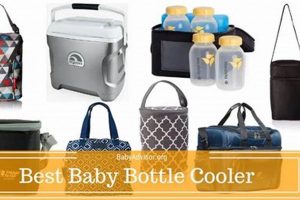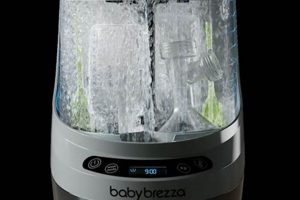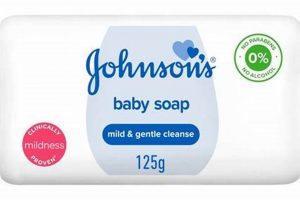The question of whether infant feeding containers have a limited lifespan is a common concern for parents. The materials used in these products, such as plastic, glass, and silicone, are subject to degradation over time due to factors like repeated sterilization, exposure to high temperatures, and normal wear and tear. This degradation can potentially affect the structural integrity of the bottle, and in some cases, lead to the leaching of chemicals from the material.
Understanding the potential for deterioration is vital for ensuring the safety and well-being of infants. Using damaged or compromised feeding equipment may present risks, including the ingestion of harmful substances or the failure of the bottle during feeding. Historically, concerns about plastic composition, particularly bisphenol A (BPA), have driven changes in manufacturing standards and increased awareness among consumers.
Therefore, this discussion will explore the types of materials used in manufacturing infant feeding bottles, common signs of wear and tear, and recommended guidelines for replacement to help parents make informed decisions regarding the safety of their baby’s feeding equipment.
Guidance on Infant Feeding Container Longevity
Maintaining the integrity of infant feeding equipment is crucial for infant safety. The following guidelines address factors affecting bottle lifespan and promote best practices for usage.
Tip 1: Material Assessment: Identify the bottle’s material composition (e.g., plastic, glass, silicone). Different materials degrade at varying rates. Plastic, for example, may become brittle or discolored with age and repeated sterilization. Glass, while more durable, can chip or break.
Tip 2: Inspect for Damage: Regularly examine feeding bottles for cracks, chips, clouding, or other signs of wear and tear. Discard any bottles exhibiting these issues to prevent potential hazards.
Tip 3: Sterilization Frequency: While sterilization is important, excessive sterilization, particularly at high temperatures, can accelerate material degradation. Adhere to manufacturer guidelines regarding appropriate sterilization methods and frequency.
Tip 4: Heat Exposure: Avoid subjecting feeding bottles to extreme temperatures, such as microwaving with formula or breast milk. Uneven heating can damage the bottle and create hot spots within the liquid.
Tip 5: Storage Conditions: Store feeding bottles in a clean, dry environment away from direct sunlight. UV exposure can contribute to the breakdown of certain plastics.
Tip 6: Replacement Schedule: Consider replacing plastic feeding bottles every few months, even if no visible damage is present. Silicone nipples should be replaced more frequently due to their softness and susceptibility to wear.
Tip 7: Follow Manufacturer Recommendations: Always consult the manufacturer’s instructions for specific lifespan guidelines and cleaning/sterilization protocols for the particular bottle type. These recommendations often provide crucial information related to the product’s intended use and longevity.
Adhering to these preventative measures ensures the safety of infant feeding practices, minimizing the risk of exposure to degraded materials and potential contaminants.
The next section will address frequently asked questions regarding infant feeding equipment maintenance and safety.
1. Material Degradation
Material degradation is a primary factor dictating the lifespan of infant feeding containers. The process involves changes in the physical and chemical properties of the bottle’s constituent materials, whether plastic, glass, or silicone. These alterations arise from various stressors, including repeated sterilization cycles, exposure to ultraviolet radiation, and mechanical stresses from normal use. For instance, prolonged use of plastic bottles may result in the breakdown of polymer chains, leading to embrittlement and potential leaching of chemical components into the infant’s formula or breast milk. The occurrence of material degradation directly answers the question of whether infant feeding bottles have a limited lifespan, as it illustrates the inherent vulnerability of these items to environmental and usage-related factors.
The effect of material degradation on the structural integrity of a bottle is profound. Cracks, fissures, and discoloration are tangible examples of this phenomenon. Consider a plastic bottle repeatedly sterilized in a steam environment. Over time, the plastic may exhibit cloudiness and a loss of flexibility, increasing the likelihood of fractures under pressure. Similarly, silicone nipples can become sticky or develop tears, impacting the flow rate and posing a choking hazard. Glass bottles, though typically more resistant, are still susceptible to chipping or shattering if subjected to impact or rapid temperature changes. Recognition of these material degradation indicators is vital for parents and caregivers to determine the suitability of the bottle for continued use.
In summary, material degradation is an unavoidable process that directly affects the expiration of infant feeding containers. Its impact on structural integrity and potential for chemical leaching necessitates regular inspection and timely replacement of compromised bottles. The understanding of this connection ensures a proactive approach to infant feeding safety, mitigating risks associated with degraded feeding equipment.
2. Sterilization effects
The process of sterilization, while crucial for eliminating harmful bacteria and ensuring infant health, exerts a significant impact on the lifespan of infant feeding bottles. Repeated exposure to high temperatures and chemical disinfectants can accelerate the degradation of bottle materials, contributing to a finite usable life.
- Polymer Chain Breakdown
Sterilization methods, such as boiling or steam sterilization, introduce thermal stress to plastic bottles. This stress can lead to the breakdown of polymer chains within the plastic matrix. The consequence is a reduction in the material’s structural integrity, potentially resulting in increased brittleness, cracking, and the leaching of chemical components. For example, polypropylene bottles subjected to frequent boiling may exhibit a decline in impact resistance, increasing the risk of fracture during normal handling. This polymer chain breakdown directly influences the determination of when baby bottles expire.
- Accelerated Chemical Leaching
Certain sterilization techniques, particularly those involving chemical disinfectants, can exacerbate the leaching of additives from plastic bottles. Bisphenol A (BPA), although largely phased out, and other plasticizers may be released at higher rates when subjected to chemical sterilization agents. This leaching poses a potential health risk to infants and compromises the safety of the feeding process. The accelerated chemical leaching contributes to the argument for a defined expiration timeline for these containers, as the cumulative exposure to released chemicals becomes a concern.
- Impact on Silicone Components
Silicone nipples and bottle components are also susceptible to degradation from sterilization. Repeated exposure to high temperatures can alter the silicone’s elasticity and texture, potentially leading to tearing or deformation. Furthermore, the sterilization process may affect the release of siloxanes from the silicone material. These changes compromise the functionality of the nipple, impacting the infant’s feeding experience and increasing the risk of aspiration. The compromised functionality due to sterilization effects necessitates that silicone baby bottle components be subject to an expiration timeline.
- Structural Weakening of Glass Bottles
While glass bottles are generally more resistant to chemical degradation than plastic, they are not immune to the effects of sterilization. Repeated heating and cooling cycles can create stress points in the glass, increasing the likelihood of cracking or shattering, especially if the bottle has pre-existing imperfections or is subjected to sudden temperature changes. Though less direct than with plastic, the potential for structural weakening due to repeated sterilization contributes to the relevance of considering a usage lifespan for glass bottles, particularly in environments where rigorous sterilization is a standard practice.
In summary, the act of sterilizing infant feeding bottles, while essential for hygiene, inevitably contributes to their degradation. Polymer breakdown, accelerated chemical leaching, silicone alteration, and potential weakening of glass, all highlight the connection between sterilization and the determination of when these bottles should be retired from use. Understanding these effects allows for informed decisions regarding replacement schedules, ultimately safeguarding infant health.
3. Visible damage
The presence of visible damage on infant feeding bottles serves as a critical indicator of compromised structural integrity and potential health risks, directly influencing considerations regarding whether infant feeding bottles have a limited lifespan. Detecting and interpreting these signs is paramount for safeguarding infant well-being.
- Cracks and Fractures
The appearance of cracks, ranging from hairline fissures to complete fractures, signifies a breakdown in the material’s structural integrity. Cracks provide pathways for bacterial colonization, rendering sterilization ineffective. Furthermore, fragmented pieces can detach, posing a choking hazard. Example: A plastic bottle dropped repeatedly may develop stress fractures invisible to the naked eye initially, gradually expanding with continued use and sterilization cycles. These fractures fundamentally compromise the bottles safety, dictating immediate replacement.
- Discoloration and Clouding
Changes in the bottle’s color, manifesting as yellowing, browning, or overall cloudiness, often indicate material degradation due to UV exposure, repeated heating, or chemical leaching. Discoloration signals alterations in the polymer structure, potentially affecting the material’s chemical stability. Example: A clear plastic bottle, after prolonged exposure to sunlight, may exhibit a yellowish tinge, suggesting the breakdown of polymer chains and the potential release of additives. Such discoloration necessitates careful assessment and may warrant bottle replacement.
- Nipple Deterioration
Visible damage to the nipple, including tears, swelling, stickiness, or changes in shape, directly impacts feeding efficiency and safety. Tears provide breeding grounds for bacteria, while changes in shape can alter flow rate, increasing the risk of choking or aspiration. Example: A silicone nipple, subjected to repeated chewing or aggressive cleaning, may develop small tears or become sticky, hindering proper latch and increasing the risk of saliva and formula accumulation within the damaged area. Such deterioration requires immediate replacement of the nipple.
- Deformation and Warping
Alterations in the bottle’s shape, such as bulging, collapsing, or warping, indicate significant material compromise. Deformation affects the bottle’s ability to withstand pressure and maintain a secure seal, increasing the risk of leaks and spills. Example: A plastic bottle repeatedly microwaved to warm formula may exhibit bulging or warping, indicating a loss of structural integrity and an increased likelihood of cracking under pressure. Deformed bottles should be discarded without hesitation.
The presence of any of these visible damages unequivocally indicates that the feeding bottle has reached the end of its serviceable life. Ignoring such signs poses a direct threat to infant safety, underscoring the importance of regular inspection and prompt replacement of compromised equipment. These indicators serve as critical determinants when assessing the temporal validity of using infant feeding bottles.
4. Chemical leaching
Chemical leaching from infant feeding bottles directly relates to the question of whether these bottles have a finite lifespan. This process involves the migration of chemical constituents from the bottle material into the contents it holds, typically infant formula or breast milk. Factors such as temperature, pH, and duration of contact influence the rate and extent of leaching. The composition of the bottle itself, including the type of plastic or the presence of additives, plays a crucial role in determining which substances may leach and in what quantities. The concern over chemical leaching underscores the importance of assessing the age and condition of infant feeding equipment, as material degradation can exacerbate the release of potentially harmful substances. For instance, polycarbonate bottles, once commonly used, were found to release bisphenol A (BPA) under certain conditions, prompting a shift towards BPA-free alternatives. This historical example illustrates how awareness of chemical leaching has shaped manufacturing practices and consumer behavior, reinforcing the concept that infant feeding bottles are not indefinitely safe for use.
The potential health effects associated with chemical leaching range from endocrine disruption to developmental issues, depending on the specific chemicals involved and the infant’s exposure level. While regulatory agencies establish limits for allowable migration of certain substances, the cumulative impact of long-term, low-level exposure remains a subject of ongoing research. Practically, this translates to recommending the replacement of feeding bottles after a defined period, even if no visible signs of damage are present. Furthermore, parents are often advised to avoid microwaving formula or breast milk in plastic bottles and to opt for gentler cleaning methods to minimize material degradation. The selection of bottle materials, such as glass or certain types of polypropylene, known for their lower leaching potential, also reflects a proactive approach to mitigating chemical exposure.
In summary, the phenomenon of chemical leaching provides a compelling rationale for acknowledging that infant feeding bottles are not immune to degradation over time and, therefore, possess a limited lifespan. Awareness of factors influencing leaching, combined with adherence to recommended replacement schedules and informed material choices, constitutes a crucial element of infant feeding safety. While the complete elimination of chemical migration may not be feasible, proactive measures can significantly reduce the risk of exposure and safeguard infant health. The ongoing research and regulatory efforts further highlight the challenges associated with ensuring the safety of infant feeding equipment and emphasize the importance of continued vigilance.
5. Usage frequency
The frequency with which an infant feeding bottle is used directly correlates with its lifespan and the potential for material degradation. More frequent use accelerates wear and tear, thereby influencing the timeline for when replacement becomes necessary.
- Increased Sterilization Cycles
Higher usage necessitates more frequent cleaning and sterilization cycles. Sterilization methods, particularly those involving heat or chemical disinfectants, can degrade bottle materials over time. A bottle used multiple times daily undergoes more frequent sterilization, leading to accelerated material breakdown compared to a bottle used less often. This increased exposure to sterilization processes directly contributes to the need for more frequent replacement.
- Elevated Exposure to Temperature Fluctuations
Frequent use often entails repeated heating and cooling cycles, whether through warming formula or storing bottles in varying temperature environments. These temperature fluctuations induce stress on the bottle material, potentially leading to cracking, warping, or increased leaching of chemicals. A bottle used consistently throughout the day is subject to greater temperature variability than one used sparingly, accelerating the degradation process.
- Greater Physical Wear and Tear
Increased usage exposes the bottle to a higher likelihood of physical damage from handling, dropping, or compression. Scratches, dents, and other forms of physical wear compromise the structural integrity of the bottle, increasing the risk of breakage or contamination. Bottles used frequently are more susceptible to such damage, thus shortening their overall lifespan.
- Accumulated Exposure to Residue
Even with thorough cleaning, repeated use can lead to a gradual accumulation of residue from formula or breast milk within the bottle. This residue can promote bacterial growth and potentially accelerate material degradation. Bottles used frequently for multiple feedings may exhibit a higher degree of residue buildup compared to those used less often, prompting more frequent replacement to maintain hygiene and safety.
The aforementioned factors highlight that usage frequency is a key determinant in assessing the lifespan of infant feeding bottles. Higher frequency of use leads to accelerated material degradation through increased sterilization cycles, temperature fluctuations, physical wear and tear, and residue accumulation. Consequently, parents and caregivers must consider usage patterns when establishing a replacement schedule for infant feeding bottles to ensure ongoing safety and hygiene.
6. Manufacturing guidelines
Manufacturing guidelines play a crucial role in determining the expected lifespan of infant feeding bottles. These guidelines encompass material selection, design specifications, and recommended usage protocols, all of which directly influence the durability and safety of the product over time.
- Material Specifications and Testing
Manufacturing guidelines dictate the specific types of materials suitable for infant feeding bottles, emphasizing safety and durability. These specifications include requirements for food-grade plastics, BPA-free formulations, and resistance to high temperatures during sterilization. Rigorous testing protocols are employed to ensure that materials meet these standards and minimize the potential for chemical leaching or degradation under normal use. The selection of appropriate materials and adherence to testing protocols significantly impact the longevity and safety profile of the bottle, influencing its expiration timeline.
- Design and Structural Integrity
Design specifications within manufacturing guidelines address the structural integrity of the bottle to withstand repeated use and sterilization cycles. Factors such as wall thickness, shape, and stress points are carefully considered to minimize the risk of cracking, warping, or breakage. Bottles designed according to stringent manufacturing guidelines are less susceptible to structural failures, extending their functional lifespan. Conversely, deviations from these specifications can compromise the bottle’s integrity, necessitating earlier replacement.
- Cleaning and Sterilization Recommendations
Manufacturing guidelines provide explicit instructions on proper cleaning and sterilization methods to maintain hygiene and prevent material degradation. These recommendations often specify acceptable temperature ranges, cleaning agents, and sterilization techniques. Adherence to these guidelines minimizes the risk of accelerated wear and tear caused by inappropriate cleaning practices, thereby prolonging the bottle’s usable life. Conversely, improper cleaning or sterilization can damage the bottle, leading to premature expiration.
- Expected Lifespan and Replacement Indicators
Some manufacturing guidelines include recommended replacement intervals or indicators of when a bottle should be discarded. These recommendations are based on extensive testing and analysis of material degradation patterns. Indicators may include changes in color, texture, or the appearance of cracks. Providing clear guidelines on expected lifespan and replacement criteria empowers consumers to make informed decisions regarding the continued safe use of infant feeding bottles.
In conclusion, manufacturing guidelines serve as a critical framework for ensuring the safety and durability of infant feeding bottles. Adherence to these guidelines, encompassing material selection, design specifications, cleaning recommendations, and replacement indicators, directly impacts the usable lifespan of the product. Understanding and following these guidelines is essential for parents and caregivers to minimize risks and maintain optimal hygiene during infant feeding.
Frequently Asked Questions
The following questions address common concerns regarding the longevity and safe usage of infant feeding bottles. The information provided aims to clarify best practices for ensuring infant health and safety.
Question 1: Do infant feeding bottles genuinely expire?
The term “expire” is not used in the same way as with perishable food items. Instead, infant feeding bottles degrade over time due to factors like repeated sterilization, use, and material composition. This degradation compromises their structural integrity and safety, necessitating replacement.
Question 2: How frequently should plastic feeding bottles be replaced?
As a general guideline, plastic feeding bottles should be replaced every few months, even if no visible damage is present. More frequent replacement is warranted if the bottles show signs of wear and tear, such as cracks, discoloration, or clouding.
Question 3: Are glass feeding bottles impervious to expiration?
While glass bottles are more durable than plastic, they are not entirely immune to expiration. Glass bottles can chip, crack, or shatter, especially if subjected to sudden temperature changes or impact. Regular inspection for damage is essential.
Question 4: How does sterilization impact the lifespan of feeding bottles?
Sterilization, while necessary for hygiene, can accelerate the degradation of bottle materials, particularly plastics. High temperatures and harsh chemicals used in some sterilization methods contribute to polymer breakdown and chemical leaching, thus shortening the bottle’s lifespan.
Question 5: What visible signs indicate that a feeding bottle should be discarded?
Any visible signs of damage, including cracks, chips, discoloration, clouding, warping, or nipple deterioration, indicate that the bottle should be immediately discarded. Continued use of damaged bottles poses a risk of bacterial contamination and potential harm to the infant.
Question 6: Do bottle nipples also have a limited lifespan?
Yes, bottle nipples, particularly those made of silicone or rubber, degrade more rapidly than the bottles themselves. Nipples should be replaced every 1-2 months, or sooner if they show signs of wear, such as stickiness, swelling, or tears. Compromised nipples can affect feeding efficiency and pose a choking hazard.
In summation, while not strictly “expiring” in the traditional sense, infant feeding bottles and their components possess a limited lifespan due to material degradation and potential safety hazards. Regular inspection, adherence to replacement guidelines, and proper cleaning practices are crucial for ensuring infant well-being.
The following section will provide conclusive insights and reinforce the significance of adhering to best practices for infant feeding equipment maintenance and replacement.
Do Baby Bottles Expire
This discourse has illuminated the various factors influencing the longevity and safety of infant feeding bottles. Material degradation, sterilization effects, visible damage, chemical leaching, usage frequency, and adherence to manufacturing guidelines all contribute to a finite lifespan for these essential items. The accumulated impact of these factors necessitates regular inspection and timely replacement of compromised feeding equipment.
Therefore, diligent attention to the condition of infant feeding bottles remains paramount. Prioritizing the selection of high-quality materials, implementing proper cleaning practices, and adhering to recommended replacement schedules are vital steps in mitigating potential risks. By embracing a proactive approach, caregivers can safeguard infant health and ensure a secure feeding experience.







